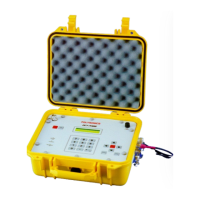7088-8000
-156
13. Enter the value of the zero point as determined in step 12 in the text box to the right of
the
ZERO FLOW
button.
NOTE:
A negative offset may be entered by first typing a minus sign.
14. Click on the
SEND
button again to resend the data to the flowmeter.
15. Reconnect the transducer wires according to their original orientation.
16. Restore the minimum and maximum flow range values if they were changed.
17. Allow the flowmeter readings to settle for ten minutes.
The flowmeter is now calibrated with the manual zero set method.
Scale Factor Calibration
After the instrument’s zero point has been set and verified, a scale factor can be set to
adjust the measured flow. The flow measured by the instrument is multiplied by this scale
factor. (For example, if the displayed flow is twice the actual flow, a scale factor of 0.5
divides the displayed flow by 2. If the displayed flow is one-half of the actual flow, a scale
factor of 2 doubles the displayed flow.)
The primary reason for setting the scale factor is to compensate the instrument for
manufacturing variations in the transducers. The scale factor is preset at the factory and is
imprinted on the transducers. If an additional scale factor is required by the user, the
additional scale factor should be multiplied by the factory scale factor and the result should
be entered in the
SCALE FACTOR
text box.
Observe the following precautions when setting the scale factor:
!
Always determine the scale factor at the highest possible flow rate achievable in order
to maximize the accuracy of the scale factor.
!
Use only the factory preset scale factor as marked on the transducers in the following
situations:
- The flow cannot be stopped to verify or set the zero point
- A reasonably high flow rate cannot be achieved
- An accurate secondary flow standard is not available

